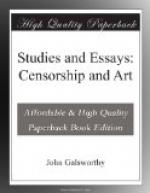So Art—I thought—is that which, heard, read, or looked on, while producing no directive impulse, warms one with unconscious vibration. Nor can I imagine any means of defining what is the greatest Art, without hypothecating a perfect human being. But since we shall never see, or know if we do see, that desirable creature—dogmatism is banished, “Academy” is dead to the discussion, deader than even Tolstoy left it after his famous treatise “What is Art?” For, having destroyed all the old Judges and Academies, Tolstoy, by saying that the greatest Art was that which appealed to the greatest number of living human beings, raised up the masses of mankind to be a definite new Judge or Academy, as tyrannical and narrow as ever were those whom he had destroyed.
This, at all events—I thought is as far as I dare go in defining what Art is. But let me try to make plain to myself what is the essential quality that gives to Art the power of exciting this unconscious vibration, this impersonal emotion. It has been called Beauty! An awkward word—a perpetual begging of the question; too current in use, too ambiguous altogether; now too narrow, now too wide—a word, in fact, too glib to know at all what it means. And how dangerous a word—often misleading us into slabbing with extraneous floridities what would otherwise, on its own plane, be Art! To be decorative where decoration is not suitable, to be lyrical where lyricism is out of place, is assuredly to spoil Art, not to achieve it. But this essential quality of Art has also, and more happily, been called Rhythm. And, what is Rhythm if not that mysterious harmony between part and part, and part and whole, which gives what is called life; that exact proportion, the mystery of which is best grasped in observing how life leaves an animate creature when the essential relation of part to whole has been sufficiently disturbed. And I agree that this rhythmic relation of part to part, and part to whole—in short, vitality—is the one quality inseparable from a work of Art. For nothing which does not seem to a man possessed of this rhythmic vitality, can ever steal him out of himself.
And having got thus far in my thoughts, I paused, watching the swallows; for they seemed to me the symbol, in their swift, sure curvetting, all daring and balance and surprise, of the delicate poise and motion of Art, that visits no two men alike, in a world where no two things of all the things there be, are quite the same.




